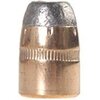For duty loadings, I've always been interested in those that were reliable and equally important, controllable with a good street rep. A good Google search here or elsewhere would turn up the old "FBI" loading for their .357's from back in the day. My searches show loadings with ~158 gr LSWHP's with velocities from 900-970 fps in Magnum brass. These were/are offered by both Remington and Winchester for gov't contract, & available for civilian use wheh you could find them.
For my own use, I find they are very comfortable in most any .357, I own. (Currently: a pair of 3" J-frame Smiths, along with 4" K-frame M19 & M66's, a 5" Smith M27, a 6" M19, and a pair of Ruger 4-5/8" bbl'd BH's.) For all of these, my standard load, based along the lines of those throwback "FBI" loads, is 5.2 gr of Bullseye with Lyman's 358156GC LSWC for 950 fps (chrono'd in both of my 4" Smith's). Using Win WSF, 6.1 gr's will get you the same velocity. Note that either load will just barely make 900 fps from my 3" Smith M60, however...but still an authoritative bullet when cast from 50-50 lead to wheel weight alloy, even more if hollow pointed.
A lot of agencies issued 125 gr JHP's at really high velocities which won the .357 its reputation as a superb street stopper, but at the cost of wear on the gun and recoil that was problematic for many officers. The "FBI" load avoided those issues, and still garnered an enviable record of service over the years.
YMMv, Rod








